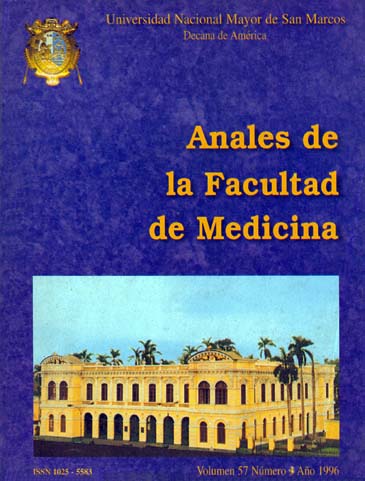Non Nosocomial Cardiac Arrest: Impact on Intensive care Units. Descriptive Study 1989-1992
DOI:
https://doi.org/10.15381/anales.v57i4.4884Keywords:
Heart arrest, Heart massage, Resuscitation, Death-Sudden, Intensive Care UnitsAbstract
Various studies slhow differences iii survival of patients who undernent CPR for non nosocomial cardiorespiratory arrest (CRA). Most patients die during CPR intent, many of the resuscitated patients die during intensive therapy after initial organic failures, and some survive with severe cerebral impaiment and high emotional, medical and social costs. ln this descriptive trial we retrospectively examined the «non nosoconfial CPR» phenonienon ocurred from 1989 till 1992, analizing data related to patients adinitted to the Emergeny Service (ES) with the diagnosis of CRA and who underwent CPR. We assessed the impact of this entity on Intensive Care Units (ICU and CCU) in relation to patient's condition at discharge and days of hospitalization. In addition, evolution of patients during 1992 was acquainted. We studied 210 patients, 55 of them attended during 1992. The average survival in ES is 32% and increased from 28,6% to 36,4%. From 68 patients successfully reanimated by the Rapid Assistance.Service (RAS), 38% were admitted to UCC and 62 % to lCU. Twenty-nine of 69 patients died in the intensive care unit (43%). Total survival for RAS has increased from 8% to 16 % (average 13,8%). Hospitalization days of patients that died in ICU usually less than patients with favourable evolution Survival of patients with ventricular fibrillation (VF) is 28%. Results obtained are not significatively different froni data encoutered in the literature.Downloads
Published
1996-12-30
Issue
Section
Trabajos originales
License
Copyright (c) 1996 Massimo Vaghi, Carla Pessina, Massimo Panozzo, Gianni Reschini, Ana Mandelli, Isaac Bayarri

This work is licensed under a Creative Commons Attribution-NonCommercial-ShareAlike 4.0 International License.
Those authors who have publications with this magazine accept the following terms:
- Authors will retain their copyrights and guarantee the journal the right of first publication of their work, which will be simultaneously subject to Creative Commons Attribution License that allows third parties to share the work as long as its author and its first publication this magazine are indicated.
- Authors may adopt other non-exclusive licensing agreements for the distribution of the version of the published work (eg, deposit it in an institutional electronic file or publish it in a monographic volume) provided that the initial publication in this magazine is indicated.
- Authors are allowed and recommended to disseminate their work over the Internet (eg: in institutional telematic archives or on their website) before and during the submission process, which It can produce interesting exchanges and increase quotes from the published work. (See El efecto del acceso abierto ).
How to Cite
1.
Vaghi M, Pessina C, Panozzo M, Reschini G, Mandelli A, Bayarri I. Non Nosocomial Cardiac Arrest: Impact on Intensive care Units. Descriptive Study 1989-1992. An Fac med [Internet]. 1996 Dec. 30 [cited 2024 Jul. 17];57(4):254-9. Available from: https://revistasinvestigacion.unmsm.edu.pe/index.php/anales/article/view/4884















